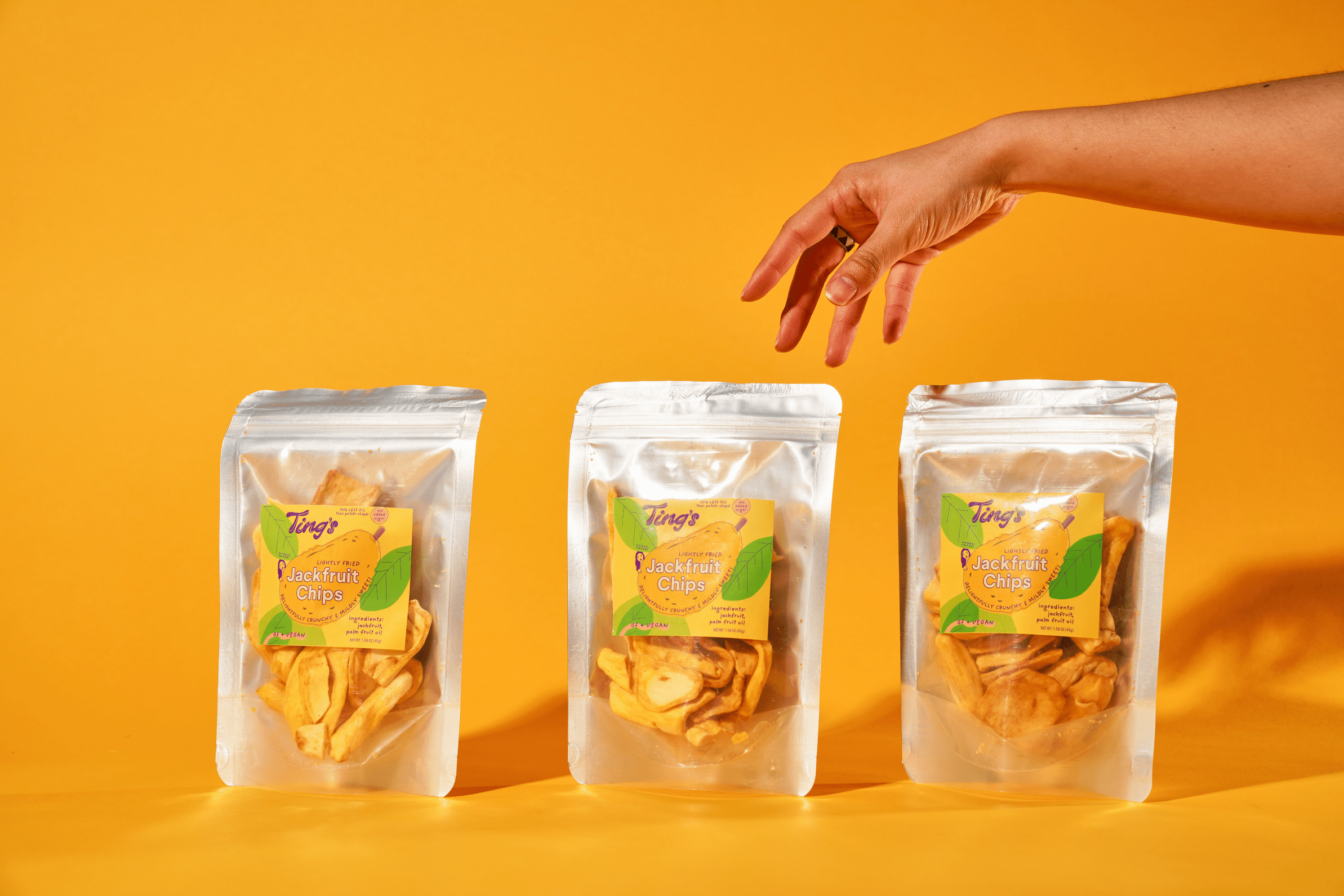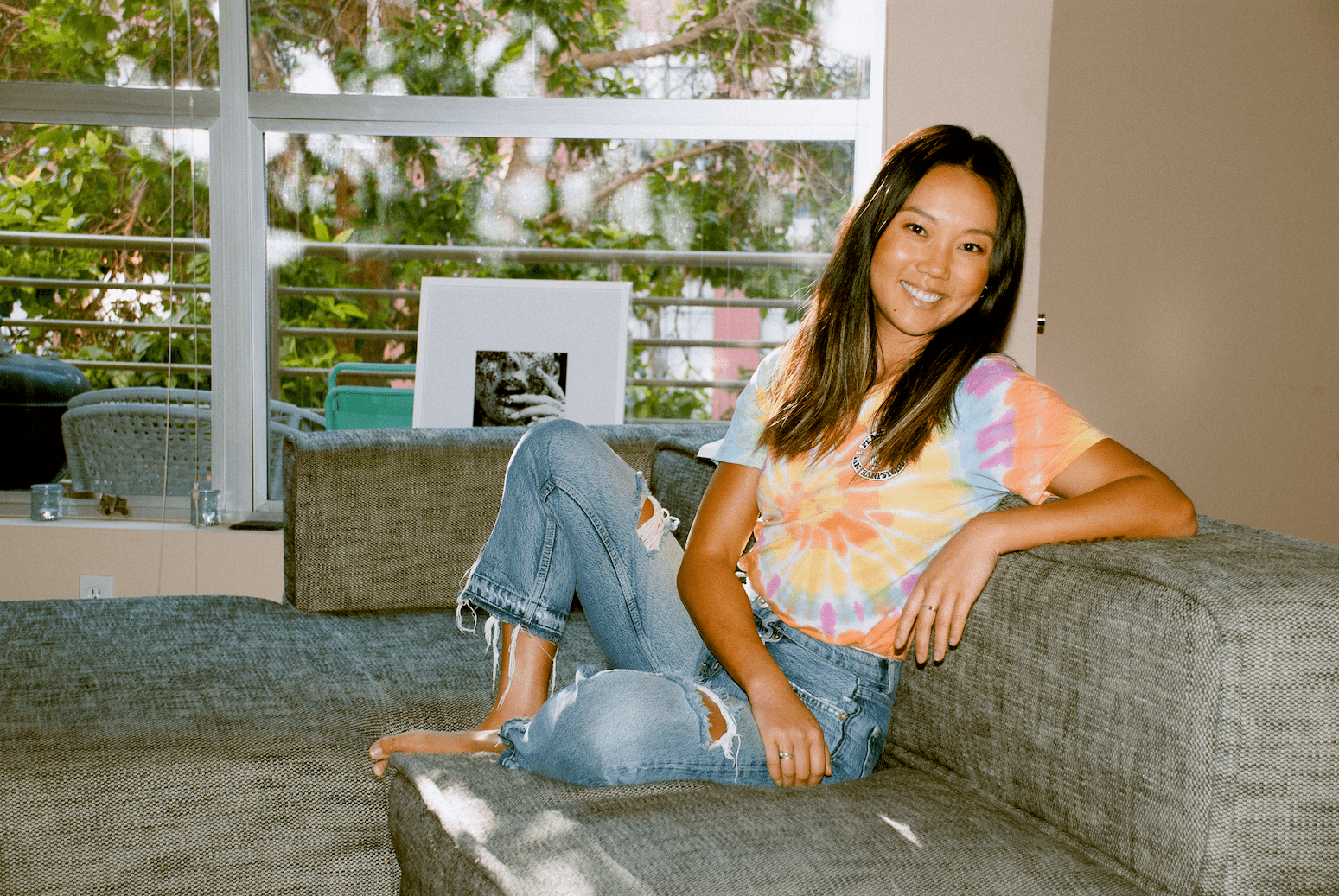Many people spent the pandemic picking up new hobbies or working on passion projects. Tiffany Wang, on the other hand, was getting ready to start Ting’s Jackfruit Chips, her San Francisco-based snack company with a social mission to end world hunger.
Wang first discovered jackfruit chips while working in Asia as a graphic designer. While not common in Western diets, jackfruit is a widely-used ingredient in desserts, savory dishes, and crunchy snacks. “A little light bulb went off in my head,” she remembers thinking when she encountered jackfruit chips. “I was like, Oh, it would be really fun to have a line of these one day — but not in a serious way. It was kind of like, This could be fun!”
A few years later, Wang decided to revisit this idea and officially launched Ting’s Chips in September 2020. The direct-to-consumer brand has slowly gained popularity as Wang introduces the product to the U.S. market.
Q&A with Tiffany Wang of Ting’s Chips
Hello Alice caught up with Wang to talk about going all-in on a business idea, getting creative with product samples during a pandemic, and finding a mission that elevates her business beyond “just” selling jackfruit chips. The following conversation has been lightly edited for length and clarity.
Is Ting’s Chips your first business, or did you have prior entrepreneurship experience?
I worked in corporate for 10 years before going freelance in design about three years ago. Throughout my years, I’ve always done entrepreneurial side projects. This is my third time launching a business, and each time the project is a little bit different. My first one ever was when I was in my early 20s, and it was women’s clothing e-commerce. The other one was a herbal medicine line.
Both of those projects I’ve done with close friends. This is the first time I’m doing this on my own. Because of COVID, I was able to do that and really focus on going it myself. And I think after having had the experience of starting and running businesses in the past, I knew what to expect in terms of that it’s never going to be easy — and that’s okay.
At this point, I’ve built realistic expectations that if I’m going to start anything, it’s going to take at least five to eight years before I see traction. I’m going to have to put in a lot of work and capital if I want to make this real. So regardless of the lessons you learned in the past, it’s still going to be a very gut-wrenching experience being a solo founder. The pace of work now has become very different, and I’ve really had to become my own co-founder and my own emotional support when it comes to day-to-day operations and leaning on myself to find consistency and persistence to keep going.
How is it like to launch a new business during COVID?
I don’t know what it’s like to launch a CPG business outside of COVID, so my go-to-market strategy was always direct-to-consumer — selling via our website and promoting through social media. I knew that we’re not able to go to farmers markets and sample at grocery stores, and that’s okay because there are other ways to go about it. One thing that I did a little differently was I offered free samples through my website. Also, in my free time, I would walk around the neighborhood and give free samples to the people in the park down the street and talk to them about the business. That was very helpful for me to find in-store demoing through on-the-ground sampling.
[Hello Alice Guide: Launch Your New Brand]
It’s really cool that you’ve found other ways to demo your product. Why did you pursue those strategies?
Most people have never heard of jackfruit, and even more people have never heard of jackfruit chips. There really isn’t a better way to explain what it tastes like unless you try them for yourself. These are costs that I’ve made peace with as a marketing expense — to offer free samples to people so that they can try it and, hopefully, if they like it, come back for a repeat order.
[Hello Alice Guide: Scale Your Food & Beverage Manufacturing]

As a new business, what is the process for building brand awareness?
That’s always the toughest thing. Most startups’ biggest hurdle is getting the name out there, and I think a big reason why a lot of companies don’t really make it past year one or two is because not enough people know about them. But in this case, I didn’t create this product. I tried it when I was in Asia, and so it’s already a tried-and-true product. I know that there’s a market for it. It’s just that it hasn’t been introduced to the Western market.
Your friends are going to be your number one source of word-of-mouth. And then from friends, it’s to family friends, then to colleagues. Beyond that, there’s social media. I’m not into purchasing followers. Organic reach is so much more important. I learned to lean on the customers that you have and to try to widen the net with a bunch of new customers who may or may not resonate with your brand. It’s really just been regularly posting on social media, reaching out to influencers — micro-influencers now, which is a more effective trend.
A new thing that I’m starting to look into myself is press releases: reaching out to editors at new publications or lifestyle magazines that your audience is regularly reading and figuring out how to get these editors on your side. When you have news or products to share, then you can tap into your resources, editors, and PR to try to help you spread the word because a lot of publications have loyal followings. So that could be a huge, huge boon if you figure out how to work the press.
You have a background in supply chain. How did you find suppliers? Do you have tips on finding supply partners?
It’s tricky, especially if you’re working with international suppliers. Nowadays, the process has been made a lot easier with platforms like Alibaba and Aliexpress if you’re looking for, you know, kind of interesting gadgets. But overall, you kind of have to trust what’s going on on the other side of the line. That’s why no major decisions are made until you’ve tried the products and confirmed them as a company and talking with people overseas.
There’s always a bit of a language barrier, so a tip that I have would be if you do find that the language is a bit of an issue, go to sources like Upwork and find virtual assistants who can act as an intermediary for some of those countries. It’s very helpful to get messages across and make sure nothing was lost in translation.
[Hello Alice Guide: Learn About Food & Beverage Distribution]
You also have a strong social mission of donating a portion of profits to fund student lunches in Cambodia. Why did you choose this cause?
In 2018, I was back in Cambodia with a tour guide learning about his village. He then invited me to go volunteer in his village, where he grew up, to help teach English to K-9 students. I spent a month there and helped do a fundraiser to get the school the supplies they needed. That felt amazing, and I wanted to do that in a bigger way.
With Ting’s right now, we are allocating 2% of profits to funding the lunches at the school that I worked with in 2018. The long-term vision is creating a structure where you buy a package of Ting’s at a store, and that package also feeds a family somewhere else in the world.
I wanted to bake the social mission into the business plan as early as possible, mostly because one, it drives the purpose of the brand, and two, if we expect to do this early on, then financially, we’re set up for it in the future. That helps the company and the people that it’s benefiting. That’s where the mission came from.
That’s amazing. Did you always plan to incorporate a mission with your business?
When I started working on this project, I had the most simplistic idea that I want to sell jackfruit chips because they’re delicious, and I want more and more people to discover them. But it kind of grew into a bigger thing of, ‘Okay, well, it seems empty to just sell jackfruit chips. If I want this to be a sustainable business in the long term, then I think something needs to be more meaningful than that.’ And when I started thinking about this, I was watching a bunch of TED Talks. One of the talks was with Simon Sinek, and he talked about the principles of why you do what you do. That got me thinking about how I want to run this business and how I want to live my life.
I feel very fortunate to be able to do something like this, starting a company and having the privilege and the means to kind of create a thing on my own terms. I think the only way to show gratitude is to help people who need help. And if I have any sort of business, I should also be able to help others.
What’s the biggest lesson you’ve learned so far as a business owner?
Being an entrepreneur is incredibly challenging. Not in just the day-to-day, not in all of the moving pieces, but emotionally. You have to be emotionally fortified to be a business owner, because most of the time, you’re going to ask yourself, What is going on? Most businesses fail in the first few years, and there’s a reason for that. It’s really hard to shoulder things that feel like failure after failure after failure, and not let that get to you.
To be an entrepreneur, I think the biggest thing that I’ve learned is I really need to have my own mental health completely taken care of. It’s different for each individual, whether that be going to therapy, having a morning ritual, having a network of friends and support around to talk things over with. It is so important to have a great outlook if you want to be a successful entrepreneur because, more than likely, you’re going to be weathering blows.
For more small business tips and inspiration create a free account on Hello Alice or subscribe to our weekly newsletter.
